03.09.11
Posted in Weather News at 8:00 am by Rebekah
Despite yesterday’s moderate risk and tornado watch for Louisiana, there wasn’t a lot of activity in this area.
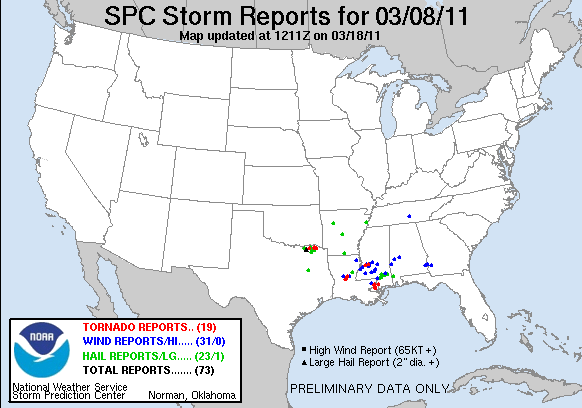
Another side to this storm system is the snow in the Upper Midwest and all the rain around the Southeast and Mississippi River Valley.
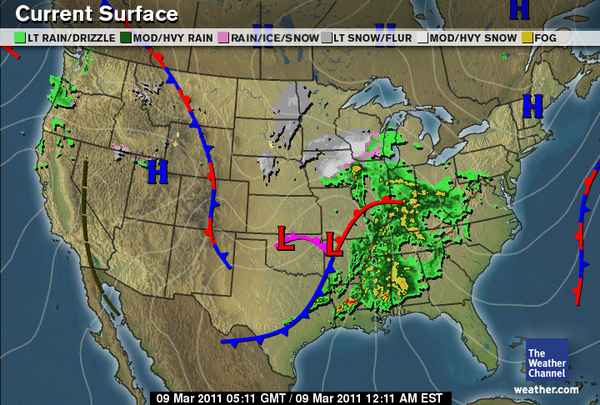
Image from The Weather Channel, at about midnight Eastern Time.
There is a slight risk for severe weather along the northern Gulf Coast today, and then after that it looks like our next chance for severe weather might be early next week or even later.
Permalink
03.08.11
Posted in Weather News at 8:00 am by Rebekah
This week’s post in the global weather and climate series features McGrath, Alaska.
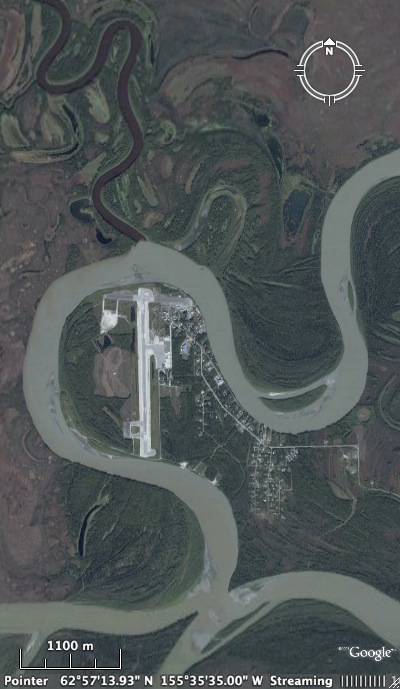
Satellite view of McGrath, on the Kuskokwim River. From the Alaska Lake Ice and Snow Observatory Network
McGrath is a town of 401 people (2000 census) on the Kuskokwim River in southwest / south central Alaska. While the village is in a valley at only 331 feet elevation, McGrath is situated on the western edge of the Alaska Range and not far from Mount McKinley.
Established as a trading post in 1904, McGrath grew with the discovery of nearby gold and the need for a supply post in interior Alaska. Today, McGrath is an important transportation hub and receives visitors every year as a result of its location along the Iditarod Trail. Mushers participating in the Iditarod race will soon be coming in to McGrath.
See the Iditarod web site for info on the current standings/locations of the teams, and see the Weather Underground Iditarod page for weather info along the trail.
A few more facts about McGrath (weather data from the Western Regional Climate Center):
- Time zone: Alaska Standard Time (UTC-9) or Alaska Daylight Time (UTC-8)
- Average elevation: 331 ft (101 m)
- Climate zone: Boreal forest / taiga (long, cold winters and short, cool summers)
- Average high temperature: 36 °F (2 °C)
- Average low temperature: 16 °F (-9 °C)
- Average annual high/low temperature range: 1 to 69 °F (-17 to 20 °C) / -17 to 50 °F (-27 to 10 °C)
- Average annual precipitation: 17 inches (434 mm)
- Average annual snowfall: 91 inches (230 cm)
Weather: McGrath experiences pretty cold winters with a fair amount of snowfall each year, though summers can be pleasant and drier. The high today is forecast at around 15 °F, with a low tonight of 10 to 15 below. Skies will remain clear and winds will be light. This weather is expected to continue through much of the week (might get a little colder towards the end of the week).
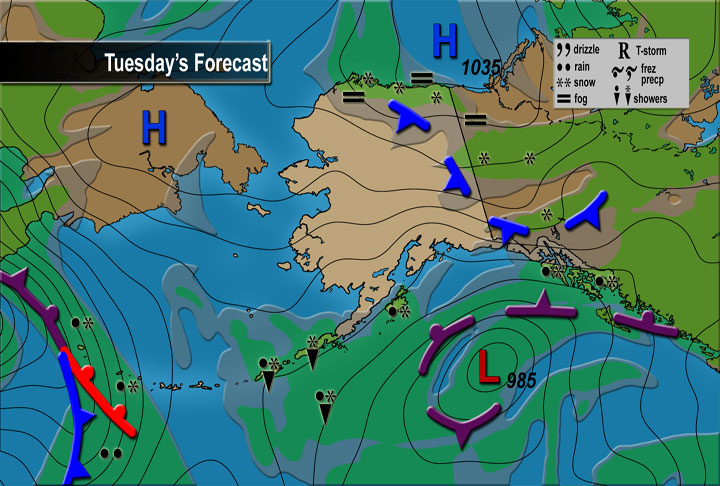
Bigger picture of what’s going on in Alaska, from the National Weather Service
For weather maps and information on current and forecast McGrath weather, see the National Weather Service and Weather Underground.
For a bit more information on McGrath, here’s a link to Wikipedia.
Next Tuesday I plan to take a look at the climate and weather in another part of the globe. As always, if you have any suggestions for future cities, please leave a comment!
Permalink
03.07.11
Posted in Weather Education at 8:00 am by Rebekah
While last week we looked at how surface observations are made, this week we’ll look at how upper-air observations are made, focusing on weather balloons (some measurements may be taken by aircraft, as well).
Radiosondes
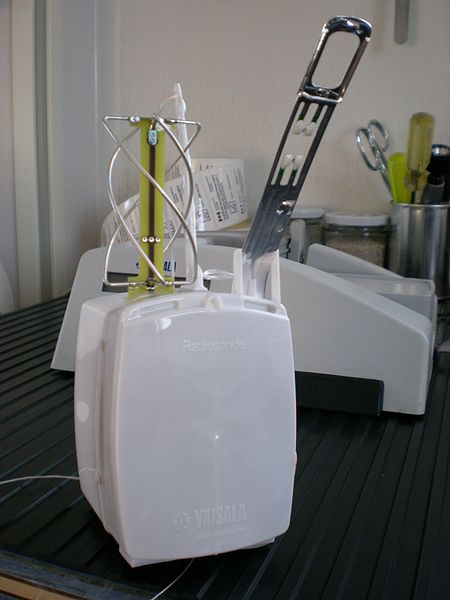
(Radiosonde photo from Wikipedia)
The primary instrument for measuring upper-air weather data is a radiosonde. A radiosonde is a small box that measures temperature, relative humidity, pressure, wind speed and direction, altitude, and GPS location. (Technically, a radiosonde doesn’t measure wind…instruments that do are called rawinsondes, but colloquially we still like to call them radiosondes.)
The radiosonde is attached to a large, hydrogen-filled balloon, which can ascend to over 100,000 feet in altitude, at which point the balloon could have expanded to the size of a two-story building! Data is transmitted to the surface throughout the balloon’s flight.
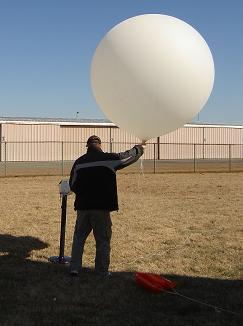
(Photo courtesy of the National Weather Service)
As the balloon expands as it rises (due to lower pressure higher in the atmosphere), it will eventually pop and come back down (sometimes prematurely). The ascension can last for two hours, at which time the instrument may have reached over 100,000 feet in altitude and may have drifted well over 100 miles away from the point of release.
Weather balloons are launched twice a day at over 400 locations around the world, around 12Z and 00Z (remember the universal time zone we talked about recently?). The following figure from the College of DuPage shows where radiosondes are launched in the U.S. (as well as southern Canada and northern Mexico). The light blue spots are supplemental sites where balloons are launched only on special occasion (in case of severe weather, snowstorm, etc.).

We’ll discuss how this upper-air data is plotted a little later in the series.
————————————————–
Next Monday we will take a look at remote sensing observations, including radar and satellite.
Permalink
03.06.11
Posted in Weather - Miscellaneous at 8:00 am by Rebekah
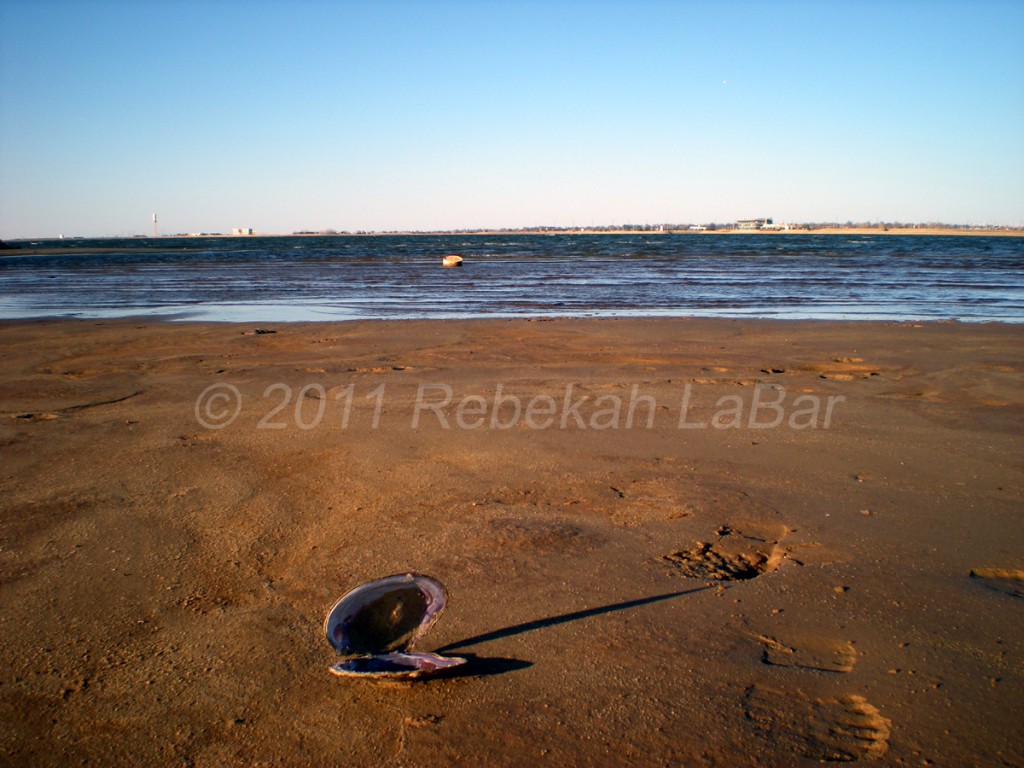
Late yesterday afternoon I went fishing at Lake Hefner, in Oklahoma City. I didn’t stay too long, as there was a fairly cold north wind and I started to get hungry. Next time I’ll remember to eat before I go, or bring food in case I don’t catch anything. 🙂
This brought to mind an article by The Weather Channel, titled “How Weather Affects Fish Activity“. Check this out if you’re into fishing, it has some interesting info on fishing weather!
Here are a few other photos I snapped at the lake (last one shows two Mallards and a Sandpiper on the left):
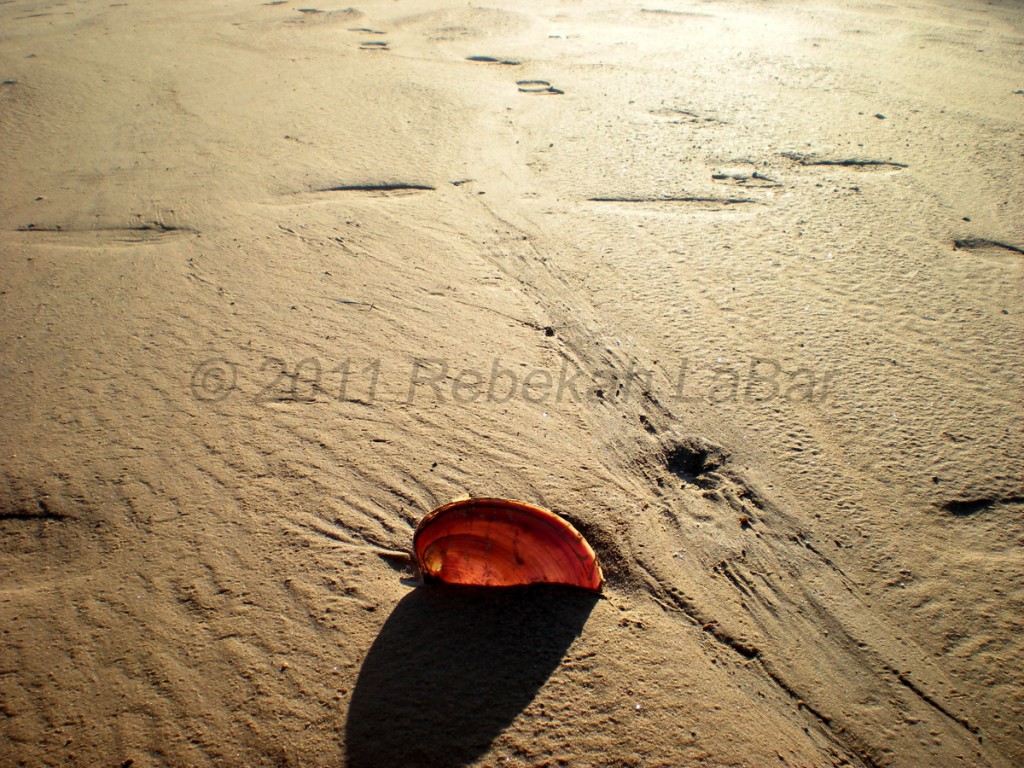

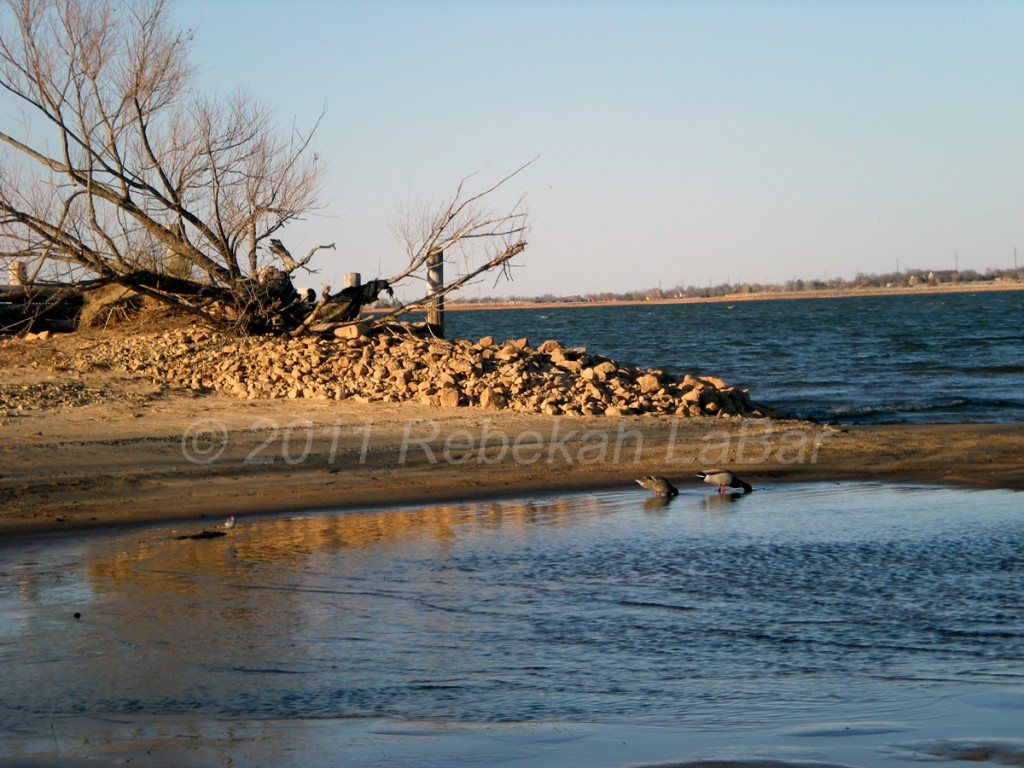
Permalink
03.05.11
Posted in Weather News, Weather Summary at 8:00 am by Rebekah
A trough is currently moving across the central U.S., with a ridge over the western part of the country.
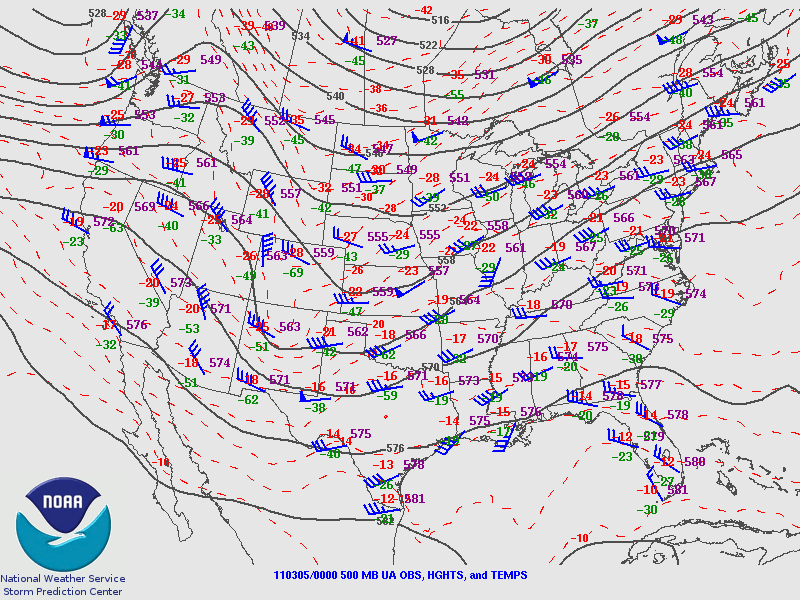
A low-pressure system is moving into the Northeast, bringing a lot of rain around and ahead of the system and some snow behind it.
The cold front extending south of the low passed through Oklahoma last night (see image below), lowering our temperatures with the arrival of a strong north wind.

This weekend, more heavy rain is expected across parts of the Midwest and some thunderstorms are possible from Ohio to Kentucky. The Weather Channel forecasts that much of this area may see 1.5 to 2.5 inches of rain, with some locally heavier amounts.
Colder air moving into Wisconsin, northern Illinois and Indiana, and Michigan will allow snow a couple inches of snow to fall and possibly even some freezing rain and/or sleet.
Much of the Southeast also is/will be experiencing rain and some thunderstorms today, though flooding is not expected to be as bad as in the Midwest.
As the low moves into the Northeast, wintry precipitation will fall today across parts of the New England area, with rain falling in Pennsylvania and New York.
As for the West Coast, rain will continue to fall in western Washington, western Oregon, and northwestern California. Some snow showers are possible in eastern Oregon and Washington into the northern Rockies. The Southwest, under high pressure, will be warm and sunny.
Permalink
« Previous Page — « Previous entries « Previous Page · Next Page » Next entries » — Next Page »












